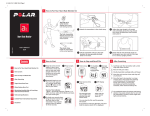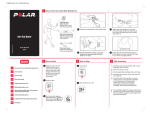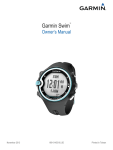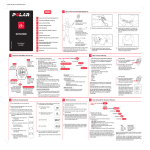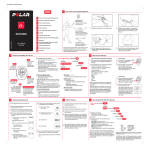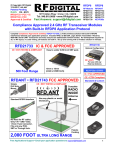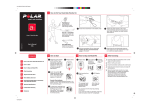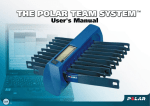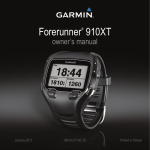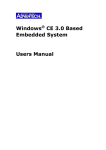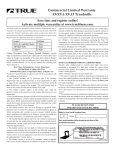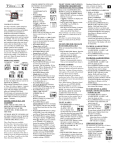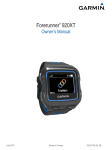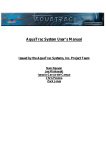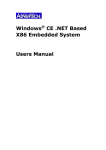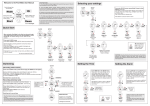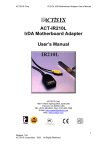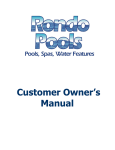Download System Specifications - ODU Computer Science
Transcript
I. GENERAL PRODUCT DESCRIPTION A. Introduction/Background Swimming, like any other sport, requires monitoring performance so it can be analyzed and improved. This tracked data can be used to identify the strengths and weaknesses of a competitive swimmer. A competent coach will work to improve a swimmer’s weaknesses, while at the same time using those swimmer’s strengths to benefit the team. The more a coach knows about his or her swimmers, the better equipped that coach is to make strategic decisions for team competitions. B. Problem With the current advances in sports, however, swimming is not meeting today’s training standards. It is true that timing equipment for swim competitions is rather advanced, but swimmers should also be monitored while they train. Current practices of tracking team data are often clumsy and inefficient. Today’s swim team coaches track swimmer data using stopwatches while the team works out. This method means that they can only track one or two swimmers at a time but most teams practice with at least twenty swimmers in the pool at one time. Once the coach times a swimmer, he must write the time down if he or she wishes to record the time. This process can draw attention away from the other swimmers. For the coach who is trying to keep swimmers focused on sets, look for ways to improve swimmer technique, and instruct swimmers on the proper way to execute drills, tracking swimmer data with current methods is often inadequate or overlooked. A swim team coach with a system that could track data for AquaTrac Functional Specifications 1 them would have a great advantage over swim team coaches using current standards of tracking. It is for this reason that we are proposing the AquaTrac system. C. Solution – The AquaTrac System We have designed a system that will serve as a complete coaching assistant. Our system will track the performance of swimmers while they train so the coach can focus on the needs of the swimmers. The system will allow the coach to motivate swimmers and direct them while they train, then work with data and strategy when practices are over. Our team has determined that there are two data points necessary to improving swimmer performance – times and distances. The AquaTrac system will track times and distances for all swimmers on a team when they work out. As a bonus, the AquaTrac will also track heart rates of swimmers while they swim. Through various studies, the AquaTrac team found that heart rates indicate important information about the effort exerted by a swimmer while he or she swims. Times and heart rates for each lap will be stored in the coach’s computer. Data will be organized into graphs and tables so the coach will be able to use workout data to create competitive strategies and improve swimmer performance. AquaTrac Functional Specifications 2 D. General Description of Hardware The Wrist Device – Worn by Team Swimmers The AquaTrac system relies on three devices that communicate with each other to collect data about swimmers. The first unit is a wrist device. Wrist devices are worn by all of the swimmers during a team workout. The wrist devices collect information about the swimmers’ workout according to when the swimmers push off of an AquaTrac touch pad. The touch pads will be mounted on the wall underwater at the starting end of the pool. Every time a swimmer pushes off of a touch pad, a radio signal emitted indicating that a lap has been completed. The wrist device monitors the swimmers’ heart rates as they swim, as well as obtaining times for every lap. The wrist monitor stores all of this information so that it can send it to the coaching station later in the day, after practice. The wrist unit also serves as a timepiece. Swimmers can monitor the time as they swim. More importantly, all the information collected by the wrist device can be displayed on the screen. If swimmers have a break during their workout they can manipulate the buttons on the devices to see their own statistics for the last set. After each practice, the coach will download all of the information from the wrist units to the main computer using infrared connectivity. The AquaTrac wrist units have to be within 2 feet of the coaching station. AquaTrac Functional Specifications 3 The Lane Unit Touch Pads The AquaTrac Lane units are touch pads as well as radio transmitters. They are placed at the starting end of each lane in your swimming pool. The touch pads will be placed such that every time swimmers push off of the starting wall of the pool, he or she will push off of a touch pad. When a swimmer pushes off of the wall, a radio signal is sent out to communicate with that swimmer’s wrist device. The radio signal has a short range underwater. This ensures that only the wrist device on the swimmer who touched the pad will receive the signal. When the wrist device receives the radio signal it stores the swimmer’s time for the last lap and the heart rate measured during the lap. AquaTrac Functional Specifications 4 The Coaching Station – Main Computer The coaching station is the coach’s information collection tool and planning center. The coach will be loading information to and from the wrist devices based on commands entered into the main coaching station. Before practices, the coach will use AquaTrac software to design a workout routine for that day. Once the routine plan is completed, the coach will load the information onto the wrist devices by placing the devices close to the computer and following simple directions provided by the AquaTrac program. After practices, the coach will load information from the wrist devices onto the main computer by placing the wrist devices close to the computer and issuing more commands to the coaching station. With the information that has been collected from the wrist devices, the coach will be able to display graphs and tables about a swimmers’ performance. The coach can run reports about their times and use heart rate statistics to generalize about the amount of effort they are putting forth. From the information provided in the AquaTrac software, the coach will be able to create more competitive strategies and help improve the times of his or her swimmers. AquaTrac Functional Specifications 5 E. General Description of Software The AquaTrac software will serve as the coach’s ultimate tool. Using the AquaTrac software, the coach will be able to set up teams into organized groups. This way, if the coach has several different groups on his team, he or she can group them such that only those swimmers will be called at a time. For instance, if the coach wishes to organize his team into different age groups, he can work with all of the ten to twelve year-olds at a time. This is useful for coaches because often they will split up their teams into different groups so that not everyone is practicing at the same time. The software also allows the coach to work with every swimmer’s workout data that has been stored from the wrist devices. Workout data is stored as times and heart rates for every lap according to the swimmer’s name, or an identification number associated with that swimmer. The coach will be able to look up any workout that the swimmer wore a wrist device and view the data in two different formats. The first way that the coach will be able to observe data is through the use of a graphical display. The coach will be able to see how swimmers compare to each other in different sets. The coach will also be able to look at how the swimmer compares to his own performance on different workouts for the same type of set. The second way that the coach will be able to observe swimmer data will be to view the information in a table format. The coach will be able to list fastest times average times and slowest times for different swimmers and the same workout set. AquaTrac Functional Specifications 6 From this information, the coach will be able to tell who are the fastest swimmers on the team, who is putting forth the most effort, and who consistently performs well in practices. Often, coaches wish to move swimmers up to higher levels of training if they consistently show that the lower level workouts are too easy. This information will help the coaches reach those conclusions. The AquaTrac software will also allow the coach to generate daily work out routines. Coaches have to plan out how much they want their swimmers to swim on a daily basis. The AquaTrac software will allow the coach to generate the practices in a format that is easy for him or her to see. Then, once the workout has been planned, it can be loaded into the wrist units using infrared communication capabilities. Finally, the AquaTrac will allow the coach to plan long-term goals for his or her swimmers. Often, coaches have to plan out long in advance the distances that the swimmers should swim for each workout in order to prepare them for competitions that are months away. The AquaTrac will allow the coach to schedule workout plans according to a yearlong calendar. AquaTrac Functional Specifications 7 F. Connectivity – General Description Data will flow between the hardware devices will occur according to the following diagram… When a swimmer pushes off of a wall to start a new lap, the touch pad will sense the touch and send a signal by means of a radio frequency. Since the radio transmission has only a range of about three feet, the swimmer who pushed off will be the only swimmer within range of the signal. The wrist device on that swimmer will receive the signal, indicating that it must store all of the tracked information for the previous lap. AquaTrac Functional Specifications 8 Once the practice is over, all of the information stored on the wrist device for that workout will be uploaded onto the main computer and stored in the main computer’s database via infrared communication. AquaTrac Functional Specifications 9 II. PRODUCT HARDWARE A. Wrist Unit device 1. Functionality a. Get this from my part of the user’s manual 2. Required Components a. Battery type: CR 2430 b. Battery life: ~2 years (av. Use, 2 hr/day for 7 day/week) c. Normal Operating Temperature: d. Water resistance: 14ºF to 122ºF (-10ºC to 50ºC) to 160 ft (50m) e. Wrist strap: polyurethane f. RF receiver: RFD27994 from www.rfdigital.com (433MHz Raw Serial Data Wireless RF Transceiver Module)* g. Backcover of unit and wrist buckle: Stainless steel in accordance with EU Directive 94/27/EU and its amendments 1999/C 205/05 on the release of nickel from products intended to come into direct and prolonged contact with the skin. h. Accuracy: better than ±0.5 sec/ day for timekeeping, better than ± 1% or ± 1bpm i. Polar S610i is a Class 1 Laser Product. 3. Measurements a. Wrist unit strap: L: 3.25 inches (top strap), 5 inches (bottom strap), W: 1/16 inch b. Wrist unit buckle: .75 inches AquaTrac Functional Specifications 10 c. Wrist unit body: L: 1.5 inches, W: 1/3 inch AquaTrac Functional Specifications 11 B. Lane Unit / Touch Pad 1. Components Necessary The following components are suggested materials for construction of the touch pad unit. - 1 50 ft (15.25 m) coated power cable with an outlet plug attached to the end. - 2 Copper Sheeting or Copper grid (55 inches (1.397 meters) wide, 18 inches (45.7 cm) high, .039 inches (1 millimeter) thick) - 12 Rubber Spacers (.039 inches (1 mm) X .039 inches (1 mm) X .039 inches (1 mm)) - Durable Plastic Molding Material - 12 Gauge Coated Copper Wiring - Coated Antenna Wiring - 1 Processor Box – A hard-wired circuit, connected to the Copper sheets, the Power supply, and the Antenna that will control the radio frequency (20 mHz at a range of 121.92 cm(4ft.)) output based on a push on the touch pad. AquaTrac Functional Specifications 12 2. Appearance and Dimensions of the Touch Pad Front View The front face of the touch pad should be 60 inches wide and 22 inches long. The pad should be colored black and white, with an upside-down “T” showing on the front. As an example of appearance, refer to Figure II.B.1. Figure II.B.1 AquaTrac Functional Specifications 13 3. Appearance and Dimensions of the Touch Pad Side View The back of the touch pad should extend 5 inches out at a right angle from the top of the touch pad. It should then extend 3.6 inches at another right angle. This is so the touch pad can hang snuggly on the gutter of a training pool. Refer to Figure II.B.2 for shape and dimensions. Figure II.B.2 AquaTrac Functional Specifications 14 4. Touch Pad Assembly The following is a suggested assemblage for constructing the Touch Pad Lane unit. Refer to Figure II.B.3 for the following sections. Figure II.B.3 A. The back of the touch pad should be constructed from heavy duty plastic. It should conform to the length and height dimensions set forth in Figure I.B.1. B. Copper Sheeting / Grid – 12 rubber spacers should be evenly distributed and molded to the front of Panel B such that when Panel B and C are placed next to each other, they are separated by a space of 1 millimeter. C. Copper Sheeting / Grid – 12-gauge wire should be soldered to one end of each copper sheet and extended into the Processor Box on Panel D. D. This panel should be constructed of silicon and adhere to the same dimensions as the copper sheeting/grid. The Processor Box should be molded onto Panel D, AquaTrac Functional Specifications 15 with antennae wire, a power cable, and 12-gauge coated copper wiring feeding into it. The antenna wiring should be woven and mounted to Panel D such that for every 2 square inches of Panel, there is wiring mounted to the Panel (for an illustration of how the antenna should be woven onto the panel refer to Figure II.B.4. Figure II.B.4 E. The front panel should be constructed of heavy duty plastic and display the image set forth by Figure I.B.1. Once all of the Panels have been constructed and assembled according to the above specifications and Figure II.B.3, Panel E should be molded to Panel A such that Panels B through D are enclosed within. The entire assembly should be sealed such that no water can enter at any point. AquaTrac Functional Specifications 16 5. Placement of Power Supply Cord !!!! Note: The Power Cord must be sealed so as mot to let any water enter any point of the device. Water leaks could result in serious injury by way of electric shock. Figure II.B.5 AquaTrac Functional Specifications 17 6. Logical Connectivity of Wiring, Functionality of Circuitry The Processor box should be assembled such that it integrates all of the connected wires into an electrical circuit that performs the following functionality. (Refer to Figure II.B.6 for connectivity.) Figure II.B.6 The Power Supply cable, the copper sheets, and the antenna wiring should be connected as an open circuit. The circuit is open where the two copper sheets are placed AquaTrac Functional Specifications 18 apart from one another. Once the touch pad is pushed, the copper sheets should touch each other, closing the circuit. When the circuit is closed, a steady Radio Frequency of 20 mHz should be transmitted from the antenna at a range of 121.92 cm (4ft.). The antenna must emit a signal strong enough to transmit at the given range through the front panel of the touch pad and transmit through water that has a hardness level of 200 ppm, a chlorine level of 1 ppm, and an alkalinity of 120 ppm. Standard pool water has a hardness level in the range of 100-300 ppm, a chlorine level in the range of 1-2 ppm, and an alkalinity measure in the range of 100-140 ppm, so the specifications designated above will suffice for accuracy. The antenna should stop transmitting once the copper sheets are no longer touching, as the elasticity of the rubber spacers will push them apart once the swimmer releases. Standard Pool Water Concentration Levels Taken from: http://www.nature2.com.au/installation.cfm AquaTrac Functional Specifications 19 C. System Requirements for Computer Workstation 1. Minimum requirements a. Infrared port i. External- USB-IR Infrared Transceiver USB to IRDA^ from www.trianglecables.com b. Memory requirements- 128 Mb RAM c. CPU requirements- 500 MHz Pentium 3 d. OS requirements- Windows 98 e. HD requirements- 800 Mb free space 2. Recommended a. Memory- 256 Mb RAM or higher b. CPU- 750 MHz Pentium 4 or higher c. OS- Windows XP d. HD- 1 GB or higher free space ^Description Supports SIR and FIR. Obtains power from USB port. Uses Standard IrDA transceivers. IrDA data rates from 2.4Kbps to 4 Mbps. Active LED indicator. Full compliance to IrDA 1.3 and USB 1.1 specifications. 4Kbyte FIFO buffer memory. AquaTrac Functional Specifications 20 Supports SIR and FIR Win98/98SE/ME/2000 NDIS USB Drivers. Supports SIR and FIR Low-Power CMOS design. *Description Transmits raw serial data to RF Digital raw data RF receivers, also receives serial data transmitted by other RF Digital raw data RF transmitters. Has 7 inch wire wip antennas for maximum range. Antenna can be cut by user to reduce range for applications that require less range. Typical maximum range is 150 feet. AquaTrac Functional Specifications 21 III. PRODUCT SOFTWARE A. Operating Platform / System Requirements The analysis/reporting application and the device driver programs must be developed to run on the following operating platform and system requirements: • Microsoft Windows 2000 or Microsoft Windows XP Server Edition • An Intel Pentium III with 500MHz or higher • A minimum of 512MB of RAM B. Data Storage / Input 1. Functionality 1. Initiating Data Transfer from the Wrist Device The device driver programs developed should be able to manage the infrared device and the IrDA port of the coach’s workstation. Upon a request from the GUI to retrieve the data, the device driver programs should interact with the infrared device to perform a wireless connection with the wrist device. Once the connection is established, the programs should initiate the data transfer. The maximum data transfer rate to be expected is 115kbps, in both directions. 2. Decoding the Received Data The device driver programs must be able to interpret and decode infrared signals into binary formats. The binary data should then be converted into appropriate ASCII codes. 3. Extracting the Received Data AquaTrac Functional Specifications 22 The incoming data from the wrist device contains the fields below. The fields are in order as listed. • Wrist Device Sequence Number • Wrist ID • Set Date/Time • Set Type • Set Interval • Elapsed Time • Average Heart Beats/Elapsed Time The “tab” ASCII character should be used to separate all of the fields except for “Average Heart Beats/Elapsed Time”. The “return” ASCII character should separate each set (record). 4. Validating Received Set Data Once the individual data fields have been properly extracted, they should be validated. Each field should be validated based on its predefined data type. The set records should be checked for duplication. Duplicated set records should be reported to the analysis/reporting application. The application should then inform the user about the error. In addition, the set dates/times should be compared with the existing data for the swimmer on the database. This validation will justify that the swimmer has not uploaded data for a second time in one day. If the validation fails, the error should be passed on to the analysis/reporting application, where it can be reported to the user. 5. Saving Set Records to Database AquaTrac Functional Specifications 23 After the set records are properly validated, they can be inserted to the appropriate tables on the local database. Required Components 3. Device Driver Programs The device driver programs should be developed using ANSI C language. Assembly language can be used if necessary. Appropriate compilers should be used such that the programs can be executed on the platform determined by part III.A. 4. Database Server Microsoft SQL Server 2000 Standard Edition should be used as the database server. The database size should be 2GB. 5. Database Design The diagrams below depict how the database should be designed. AquaTrac Functional Specifications 24 Database Diagram with Primary (PK)/Foreign Key Relationships • swimmer.team_id (FK) references team.team_id (PK) • set.swimmer_id (FK) references swimmer.swimmer_id (PK) • set.set_type_id (FK) references set_type.set_type_id (PK) • set_detail.set_id (FK) references set.set_id (PK) Team Table AquaTrac Functional Specifications 25 Swimmer Table Set Table Set Type Table AquaTrac Functional Specifications 26 Set Detail Table 6. Database Application The database application used to insert set records from the upload text file to the database should be written in Microsoft Visual C++. When inserting set records, the application should maintain the integrity of the database by conforming to the rules mentioned above. 7. Infrared Device The infrared device ACT-IR210L (see pictures below) from ACTISYS Corporation (www.actisys.com) must be used for the coach’s computer. The device driver programs should be developed for the ACT-IR210L. Please refer the company’s web site for detail specifications of the ACT-IR210L. AquaTrac Functional Specifications 27 Infrared Device ACT-IR210L from ACTISYS Corporation AquaTrac Functional Specifications 28 C. Formatting Specifications for the Application Software This section represents the specifications for the AquaTrac application program. It will constitute the basis for programming this segment of the AquaTrac system. Format descriptors will sometimes precede the text descriptions of the input and display fields in this section. “A” meaning “alphanumeric” is restricted to the set of all printable characters in the ASCII range from 0 to 127. When followed by a number, this descriptor indicates the number of characters allowed in that field. For example, A4 means 4 alphanumeric characters. “I” meaning “integer” is restricted to the set of all non-negative integers. When followed by a number, this descriptor indicates the number of digits allowed in that field. For example, I4 means an integer of no more than 4 digits. “F” meaning “floating-point” is restricted to the set of all non-negative floating-point numbers. When followed by a number, this descriptor indicates the number of digits allowed before and after the decimal point in that field. For example, F4.2 means a floating-point number of 4 digits before the decimal place and 2 digits after the decimal place. “L” meaning “logical” is restricted to the a value of 0 or 1 (“yes” or “no) AquaTrac Functional Specifications 29 Terminology “Swimmer” – A swimmer on a Team “Swimmer Name” – The name of a Swimmer “Swimmer ID” – The unique identifier assigned to each Swimmer “DOB” – The date of birth of a Swimmer “Height” – The height of a Swimmer “Weight” – The weight in pounds of a Swimmer “Team” – A swim team existing in the system “Teams” – The set of Team Names “Team Name” – The name of the Team “Team ID” – The unique identifier assigned to each Team “Set” – A particular swim set for a Swimmer “Set Type” – The stroke type of for a Set “Set Date” – The date a particular Set was recorded “Set Interval” – The distance interval at which Interval Times and Heart Rate are recorded. “Set Distance” – The total distance for a particular Set “Interval Time” – The time recorded at each Set Interval “Set Time” – The total elapsed time for a Set “Heart Rate” – The total number of heartbeats recorded at each Set Interval AquaTrac Functional Specifications 30 “Data” – All of the recorded/historical data for a Team Common Field Formats Certain formats appearing in multiple segments of this section are given here: § Swimmer First Names should be A25 § Swimmer Last Names should be A25 § Swimmer IDs should be I and fixed at 6 digits § Team Names should be A50 § Team IDs should be I and fixed at 6 digits. § DOBs should be formatted as DD/MM/YY § Height should be formatted as FEET’ INCHES” § Weight should be I3 § Set Type is A and can only be “freestyle”, “backstroke”, “breaststroke”, “butterfly”, or “mixed” § Set Date should be formatted as DD/MM/YY § Set interval is I4, can only be a multiple of 50, and can be no greater than 5,000. § Interval time should be formatted as HOUR.MINUTES.SECONDS § All time fields should be formatted as HOUR.MINUTES.SECONDS § Heart Rate should be I3 General Notes A global Team ID should be used as the identifying key for access to Team data. For purposes of this specification, this global Team ID will be called Global Team ID. AquaTrac Functional Specifications 31 D. Application Functions Application Menu The application menu should provide all the menu items necessary to access the various functions of the application program. Open Team Description: To set the Global Team ID for data access. Required input field for this function: § Teams If the Team Name is valid, the Global Team ID should be set to the Team ID. The Global Team ID will be used to: § access Swimmer data for all relevant functions § set an output field for all relevant functions New Team Description: To add a new Team to the system Required input field for this function: § Team Name The new Team will be added to the system at the database level. AquaTrac Functional Specifications 32 Edit Team Description: To edit the Team Name currently opened. Required input field for this function: § Team Name The new Team Name will be changed in the system at the database level. Remove Team(s) Description: To set a Team’s account to an inactive status. Required input field for this function: § Team Name § L: prompt user to proceed with removal If the prompt returns yes, all changes to the Team’s account will be done at the database level. All Swimmer accounts for the Team will also be set to an inactive status. Close Team Description: To reset the Global Team ID to non-accessible value Required input field for this function: § L: prompt user to proceed with close If the prompt returns “Yes”, the Global Team ID will be reset to a non-accessible value. AquaTrac Functional Specifications 33 Exit Description: To exit the program There are no requirements for this function other than to exit the application. Edit Description: To provide the standard functions necessary for editing input text. These standard functions should include “undo”, “redo”, “cut”, “copy” and “paste” Table Builder Description: To obtain the values necessary to build the Table Builder Report (See a description of this report in the Reports section). Terminology for this function: “Start Date” – Date at which to start search for Swimmer data “End Date” – Date at which to end search for Swimmer data Required input fields for this function: § 3 instances of Swimmer Name § Set Distance § Set Type § Start Date § End Date AquaTrac Functional Specifications 34 Each value of Swimmer Name should be unique (A particular Swimmer should not be selected more than once). At least one Swimmer Name must be selected. The function should find only those Sets that correspond to the values for Set Distance and Set Type, and are in the range specified by Start Date and End Date. Graph Builder Description: To obtain the values necessary to build the Graph Builder Report (See a description of this report in the Reports section). Terminology for this function: “Start Date” – Date at which to start search for Swimmer data “End Date” – Date at which to end search for Swimmer data “Graph Type” – The type of graph to be displayed in the Graph Builder Report “Set Number” – The particular Set to be graphed in the Graph Builder Report Required input fields for this function: § 3 instances of Swimmer Name § Set Distance § Set Type § Start Date § End Date AquaTrac Functional Specifications 35 § A: Graph Type – can only be “Averages”, “Single Race (Individual)”, or “Single Race (Multiple Individual)” § A: Set Number – should be formatted as SET:NUMBER - DATE Each value of Swimmer Name should be unique (A particular Swimmer should not be selected more than once). At least one Swimmer Name must be selected. The function should find only those Sets that correspond to the values for Set Distance and Set Type, and are in the range specified by Start Date and End Date. From the Sets found for each Swimmer, the user should select a Set Number to graph in the Graph Builder Report. Load Swimmer Data Description: To initiate the data transfer between the wrist monitor and the database. Required input fields for this function: § L: prompt user to proceed with data transfer If the prompt returns “Yes”, the data transfer process will begin. Add Swimmer(s) Description: To add a new Swimmer to a Team Required input fields for this function: § Swimmer Name AquaTrac Functional Specifications 36 § DOB § Height § Weight The new Swimmer will be added to the Team at the database level. Remove Swimmer(s) Description: To set a Swimmer’s account to an inactive status. Required input field for this function: § Swimmer Name § L; prompt to proceed with removal If the prompt returns “Yes”, all changes to the Swimmer’s account will be done at the database level. Schedule Description: To provide a “notepad” for entering text to be associated with a particular calendar day. Terminology for this function: “Date” – a calendar day “Notes” – the text associated with the Date Required input/output fields for this function: § Date (input only) AquaTrac Functional Specifications 37 § A500: Notes (input and output) Notes are entered, modified and viewed in the same field. Notes are saved for the Date selected upon exiting the function. Setup Practice Description: To store a collection of Sets for a particular workout routine. Terminology for this function: “Date” – a calendar day “Workout” – A set of Sets to be completed during the workout routine Required input fields for thus function: § Date § Set Distance § Set Type § L: Prompt to add the set to the workout routine If the prompt returns “Yes”, a Set will be added to the Workout for the Date selected. The Set will specify the Set Distance and Set Type. Multiple Sets can be added consecutively to the Workout. Workouts are saved upon exiting the function. View User Manual Description: To display the product user manual. AquaTrac Functional Specifications 38 The user manual will open in Portable Document Format for viewing upon execution of this function. AquaTrac Functional Specifications 39 E. Application Reports Table Builder Report Description: The output generated from the Table Builder function. Terminology for this report: “Average Time ” – The average Set Time for the Sets retrieved “Best Time” – The shortest Set Time for the Sets retrieved “Worst Time” – The longest Set Time for the Sets retrieved Required output fields for this report: § 3 instances of the Swimmer Name § Set Distance § Set Type § Average Time § Best Time § Worst Time § Start Date § End Date Set Distance, Set Type, Start Date and End Date should be headers for this report. Average Time, Best Time and Worst Time should be displayed for each Swimmer. An example of the table format is shown below: AquaTrac Functional Specifications 40 Graph Builder Report Description: The output generated from the Graph Builder Function. Terminology for this report: “X-Axis” – the x-axis of the graph; the axis for which Interval Distance is plotted “Y-Axis” – the y-axis of the graph; the axis for which Interval Time is plotted “Distance/Time Point” – the intersection of Interval Time and Set Interval. Averages Report Description: To graph the Average Set Times for each Swimmer selected Required fields for this report: § 3 instances of Swimmer Name § Set Distance § Set Type § A: Set Number – should be formatted as SET:NUMBER - DATE § Average Time § Start Date § End Date § Interval Distance AquaTrac Functional Specifications 41 § Interval Time § Heart Rate Swimmer Name, Set Distance, Set Type, Set Number, Start Date and End Date should be headers for this report. The X-Axis should be plotted as Set Intervals up to the Set Distance. The Y-Axis should be plotted in a range from 0 to 60 seconds. Interval Time for Average Time should be plotted at each Set Interval. Heart Rate should be displayed above each Time/Distance Point. An example of this graph is shown below: AquaTrac Functional Specifications 42 Single Race Individual Description: To graph multiple Sets for a Swimmer Required fields for this report: § Swimmer Name § Set Distance § Set Type § A: Set Number – should be formatted as SET:NUMBER - DATE § Start Date § End Date § Interval Distance § Interval Time § Heart Rate Swimmer Name, Set Distance, Set Type, Set Number, Start Date and End Date should be headers for this report. The X-Axis should be plotted as Set Intervals up to the Set Distance. The Y-Axis should be plotted in a range from 0 to 60 seconds. Interval Time for the Set Times should be plotted at each Set Interval. Heart Rate should be displayed above each Time/Distance Point. An example of this graph is shown below: AquaTrac Functional Specifications 43 Single Race (Multiple Swimmer) Description: To graph multiple Sets for multiple Swimmer. Required fields for this report: § 3 instances of Swimmer Name § Set Distance § Set Type § A: Set Number – should be formatted as SET:NUMBER - DATE § Start Date § End Date § Interval Distance § Interval Time § Heart Rate AquaTrac Functional Specifications 44 Swimmer Name, Set Distance, Set Type, Set Number, Start Date and End Date should be headers for this report. The X-Axis should be plotted as Set Intervals up to the Set Distance. The Y-Axis should be plotted in a range from 0 to 60 seconds. Interval Time for the Set Times the should be plotted at each Set Interval. Heart Rate should be displayed above each Time/Distance Point. An example of this graph is shown below: AquaTrac Functional Specifications 45 IV. WRIST DEVICE SOFTWARE A. Operating Platform/System Requirements The software application and the device driver programs must be developed to run on the same microprocessor as the s610i (see below) from Polar USA. Please refer to the company’s web site (www.polarusa.com) for detail specifications for the s610i. S610i from Polar USA B. Interfacing with the Coaching Station 1. Functionality 1. Accepting Request for Data Transfer Upon receiving a request for data transfer from the coach computer, the device programs should interact with the infrared module of the wrist device to send a signal, indicating acceptance. 2. Preparing Set Data for Transfer Once the infrared link is established, the device programs should interface with the storage device and begin retrieving the set data. The set data should be placed temporarily in memory so it can be accessed and translated into infrared wave forms. AquaTrac Functional Specifications 46 3. Transferring Set Data The device driver programs should access the set data (binary format) in memory and convert it into appropriate infrared signals. The infrared device should then be triggered to send the signals to the coach computer. The set data to be sent should include the following: • Wrist Device Sequence Number • Wrist ID • Set Date/Time • Set Type • Set Interval • Elapsed Time • Average Heart Beats/Elapsed Time 4. Detecting and Correcting Transmission Error During data transfer, the device driver programs should be able to detect and correct synchronization errors. 2. Required Components 1. Device Driver Programs The device driver programs should be developed using ANSI C language. Also, assembly language can be used when necessary. Appropriate compilers should be used so that the programs can be executed properly on the platform mentioned on part IVA. 2. Infrared Device AquaTrac Functional Specifications 47 The device driver programs should be developed for the infrared device existed on the S610i from Polar USA. Please refer the company’s web site (www.polarusa.com) for detail specifications of the infrared device. C. Interfacing with the Touch Pad 1. Functionality 1. Required Processes While the AquaTrac wrist device is in “workout” mode, the processor must continually increment time in units of minutes, seconds, hundredths of a second, and increment heartbeats according to sensation signals received via the heart monitor sensor. 2. Receiving Radio Signal from Touch Pad Upon receiving a radio signal from the touch pad, the wrist device processor must calculate heart rate by dividing the number of heartbeats by the current elapsed time. It must then store both time and heart rate according to the data fields, “Elapsed Time” and “Average Heart Beats/ Elapsed Time”, defined in the Transferring Set Data section on the previous page. The processor then must reset both counts of time and heart beat. AquaTrac Functional Specifications 48
















































